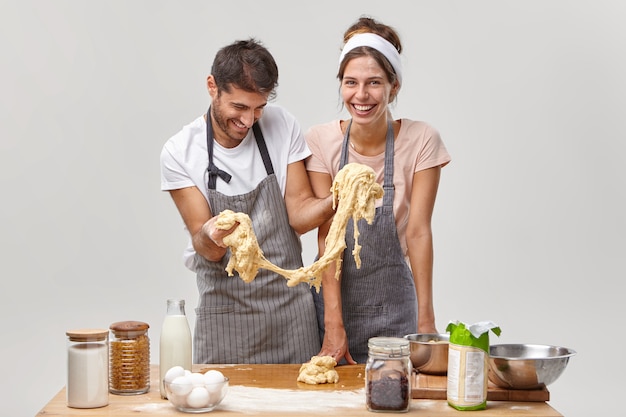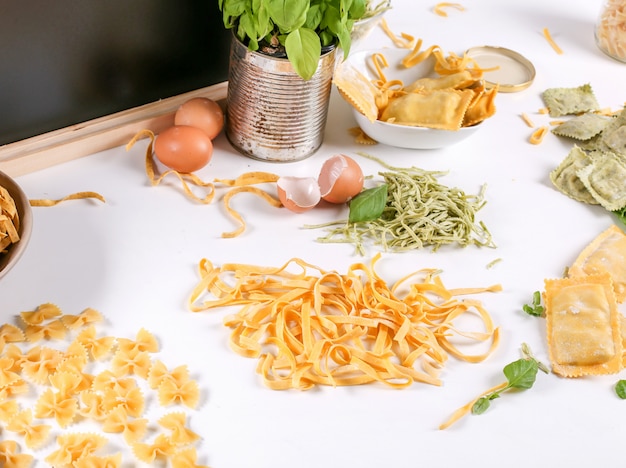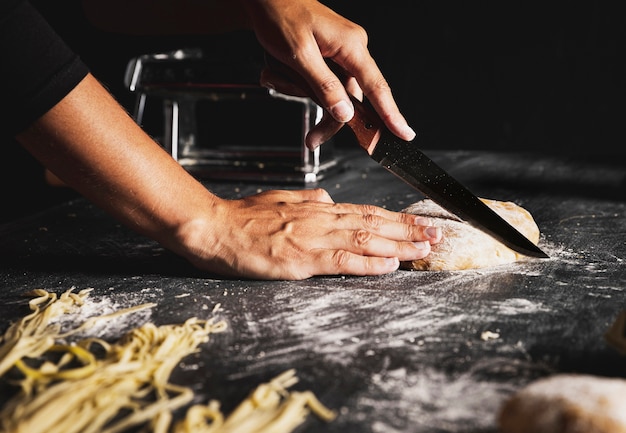(Part 1) A World of Pasta Shapes and Types

The first step to pasta perfection is understanding the different types of pasta out there. It’s a world of shapes and sizes, each with its own unique character and cooking time.
Types of Pasta
Let's start with the basics:
- Long pasta: These elegant strands are perfect for twirling around a fork and soaking up sauce. Think spaghetti, linguine, fettuccine, and tagliatelle, each with its own subtle difference in thickness and texture.
- Short pasta: Perfect for catching sauce in their grooves and creating hearty, satisfying dishes. Penne, rigatoni, farfalle (bow tie), and fusilli (corkscrew) are just a few examples, each offering unique shapes and textures to play with.
- Filled pasta: These little parcels of deliciousness are packed with flavor. Ravioli and tortellini are classic examples, often filled with cheese, meat, or vegetables. They're typically cooked in a broth or sauce and make for a truly special meal.
- Other pasta: Beyond these main categories, there's a whole world of unique pasta shapes waiting to be explored. Orzo (tiny rice-shaped pasta) is perfect for salads and soups, while conchiglie (shell-shaped pasta) is ideal for holding creamy sauces and fillings.
While there are hundreds of pasta shapes, don't feel overwhelmed! Knowing the basic categories is a great starting point, and you'll naturally learn more about different shapes as you explore and experiment.
The Importance of Texture
The key factor influencing cooking times? The shape and thickness of the pasta. Thin spaghetti cooks much faster than thick rigatoni. This is because thinner pasta has less surface area to absorb water and cook through. Keep this in mind as you choose your pasta and plan your cooking times.
(Part 2) The Quest for Al Dente

Remember that phrase, "al dente"? It's an Italian term meaning "to the tooth," and it's the holy grail of pasta cooking. al dente pasta has a slight bite to it, a firm texture that’s not mushy or soft. It’s a delicate balance, with just enough firmness to hold its own against the sauce, but not so hard that it's chewy.
Achieving al dente is essential for a truly enjoyable pasta experience. Overcooked pasta becomes mushy, losing its texture and flavour. It's a culinary tragedy we want to avoid at all costs! So, how do you know when your pasta is perfectly al dente?
Testing for Al Dente
The best way is to taste test. Toward the end of the recommended cooking time, scoop out a piece of pasta and bite into it. It should offer a slight resistance, not crumbling easily, but also not feeling hard or undercooked. This is your al dente sweet spot!
(Part 3) The Magic of fresh pasta

Now, let's talk about fresh pasta, a culinary treasure that deserves its own spotlight. Made with eggs and flour, it has a unique texture and flavor that's simply divine. Fresh pasta cooks much faster than dried pasta, and it's a culinary treat worth seeking out.
The Fresh Pasta Advantage
Fresh pasta has a delicate, almost fluffy texture, and it absorbs sauces beautifully, bringing out the best in every flavor. It's also incredibly fresh and vibrant, making for an unparalleled culinary experience.
cooking fresh pasta
You can typically tell when fresh pasta is ready by its appearance – it will float to the surface of the boiling water. Be gentle with it, as it’s more delicate than dried pasta and cooks very quickly.
If you're lucky enough to find fresh pasta at your local market, don't hesitate to give it a try. You'll be amazed by the difference in texture and flavor.
(Part 4) The Pasta Cooking Time Guide
Now, let’s get down to the nitty-gritty – the cooking times. Here's a handy table with approximate cooking times for various pasta shapes. Remember, these are just guidelines, and actual cooking times can vary based on factors like pasta brand, size, and the amount of water in your pot.
| Pasta Type | Cooking Time (minutes) |
|---|---|
| Spaghetti | 8-10 |
| Linguine | 8-10 |
| Fettuccine | 8-10 |
| Tagliatelle | 8-10 |
| Penne | 10-12 |
| Rigatoni | 10-12 |
| Farfalle | 10-12 |
| Fusilli | 10-12 |
| Ravioli | 3-5 |
| Tortellini | 3-5 |
| Orzo | 8-10 |
| Conchiglie | 10-12 |
Remember, fresh pasta cooks much faster than dried pasta, usually in just a few minutes. You’ll likely find the recommended cooking time printed on the packaging.
(Part 5) Mastering the Pasta Cooking Process
With a basic understanding of pasta types and cooking times, let's move on to the actual cooking process. It’s simple, but there are a few key steps to ensure you get consistently delicious results.
Step 1: Gather Your Ingredients
Start by gathering your essentials: pasta, water, and salt. A large pot is essential – you need plenty of space for the pasta to move freely and cook evenly. A good rule of thumb is to use 1 litre of water for every 100g of pasta.
Step 2: Bring the Water to a Rolling Boil
Fill your pot with water and bring it to a roaring boil. A rolling boil means you see a continuous stream of bubbles rising to the surface. This is crucial because the water needs to be hot enough to cook the pasta quickly and evenly.
Step 3: Salt the Water
Once the water is boiling, add a generous amount of salt. This seasons the pasta and prevents it from sticking together. Don’t be shy with the salt! A tablespoon per litre of water is a good starting point.
Step 4: Add the Pasta
Slowly add the pasta to the boiling water, stirring gently to prevent sticking. Don't add it too quickly – you want to avoid cooling down the water and creating uneven cooking.
Step 5: Stir Occasionally
As the pasta cooks, give it a stir every few minutes to prevent it from sticking to the bottom of the pot. Keep a close eye on the pasta as it nears the end of its cooking time, ready to check for that perfect al dente.
Step 6: Taste Test
When the pasta is almost cooked, remove a piece and taste it. Is it al dente, with a slight bite? If it’s too soft, cook it for a bit longer. If it’s still firm, give it another minute or two.
Step 7: Drain the Pasta
Once the pasta is cooked, drain it in a colander. Don't over-drain it – you want to reserve some of the pasta water, known as "starchy water," for your sauce. This starchy liquid helps thicken your sauce and adds a wonderful flavor boost.
Step 8: Serve with Your Favorite Sauce
Now, the moment of truth! Serve your perfectly cooked pasta with your favorite sauce and savor every bite.
(Part 6) Pasta cooking tips: Level Up Your Skills
Now that you have the basics down, let's delve into some helpful tips to take your pasta cooking to the next level.
Tip 1: Don't Overcrowd the Pot
Avoid adding too much pasta to the pot at once, as this can lower the water temperature and lead to uneven cooking. For larger groups, it’s best to cook the pasta in batches.
Tip 2: Use Quality Pasta
This might seem obvious, but it's worth emphasizing. Choose high-quality pasta, made with durum wheat semolina. It gives the pasta a firm texture and a better bite.
Tip 3: Don't Rinse the Pasta
Unless you're making a cold pasta salad, don't rinse the pasta after draining. Rinsing washes away the starch, which is essential for the sauce to cling to the pasta.
Tip 4: Don't Overcook the Pasta
Remember, al dente is your goal! Overcooked pasta loses its texture and flavor. Keep a close eye on the cooking time and don't hesitate to taste test along the way to ensure it’s cooked to your liking.
Tip 5: Enjoy the Process
cooking pasta is a simple but satisfying process. So, relax, enjoy the aromas filling your kitchen, and savor the anticipation of a delicious pasta dish.
(Part 7) pasta sauce Inspiration: Beyond the Basics
A good sauce elevates a pasta dish from good to great. But with so many options, where do you begin? Here are some classic and unique sauce ideas to get you started.
Classic pasta sauces
- Tomato Sauce: This classic is incredibly versatile, and it can be made with fresh or canned tomatoes. Add herbs like basil and oregano, garlic, onions, or a touch of chili for a flavor boost.
- Cream Sauce: Rich and decadent, cream sauce is often made with heavy cream, butter, and Parmesan cheese. It's a perfect pairing for carbonara or Alfredo.
- Pesto Sauce: Fresh and vibrant, pesto is made with basil, pine nuts, garlic, olive oil, and Parmesan cheese. It's a delicious combination with linguine or penne.
- Bolognese Sauce: A hearty and flavorful sauce, bolognese is made with ground beef, tomatoes, onions, carrots, and celery. It's traditionally served with tagliatelle or spaghetti.
Unique Pasta Sauces
- Spicy Arrabbiata Sauce: A fiery delight, arrabbiata is made with tomatoes, garlic, and chili peppers. It’s a great option for short pasta like penne or rigatoni.
- Mushroom Sauce: Rich and earthy, mushroom sauce is made with mushrooms, garlic, and white wine. It's a wonderful choice for those who don't like tomato-based sauces and pairs well with any pasta shape.
- Lemon Garlic Sauce: A bright and refreshing sauce, lemon garlic sauce is made with lemon juice, garlic, olive oil, and Parmesan cheese. It’s a delicious way to add a touch of sunshine to your pasta dish.
Pasta Sauce Tips
Remember, there are no hard and fast rules when it comes to pasta sauce. Feel free to experiment and let your creativity guide you. If you're short on time, there are many delicious pre-made sauces available, but always look for good quality options!
(Part 8) Pasta Beyond the Plate: Expanding Your Culinary Horizons
Pasta isn't just for dinner. It's a remarkably versatile ingredient that can be incorporated into a wide range of dishes, from salads and soups to even desserts!
Pasta Salads
Pasta salad is a light and refreshing meal, perfect for warm weather. Short pasta like penne or farfalle hold up well in a salad. Combine your cooked pasta with your favorite vegetables, protein (like chicken, shrimp, or tofu), and a flavorful dressing.
Pasta Soup
Pasta soup is a comforting and hearty dish, ideal for a chilly day. Small pasta shapes like orzo or ditalini cook quickly and soak up the flavors of the broth. Simply add your cooked pasta to your favorite soup recipe and enjoy.
Pasta Dessert
Yes, you read that right – pasta can even be used in desserts! It might sound unusual, but it's truly delicious. Use pasta to make a sweet pudding, or bake it into a crumble. It's a creative way to use up leftover pasta and expand your culinary horizons.
FAQs: Your Pasta-Related Questions Answered
Here are answers to some common pasta-related questions that might be swirling in your mind.
1. Can I Overcook Pasta?
Absolutely, and it's something we want to avoid. Overcooked pasta becomes mushy and loses its texture. Remember, aim for al dente!
2. What Happens If I Add Too Much Salt to the Water?
Don't worry, it won't ruin your pasta. Just try to use less salt next time. However, if you've added a lot of salt, it might make the sauce salty, so keep that in mind when seasoning.
3. What Can I Do with Leftover Pasta?
Leftover pasta is a culinary treasure. Add it to salads, soups, or stir-fries. You can also freeze leftover pasta for later use.
4. Should I Rinse the Pasta After Draining?
Unless you're using the pasta in a cold salad, don't rinse it. Rinsing washes away the starch, which helps the sauce cling to the pasta.
5. Can I Use Tap Water to Cook Pasta?
Yes, you can use tap water. However, if your tap water is hard, it might give the pasta a slightly metallic taste. If possible, use filtered water.
There you have it, your ultimate guide to pasta cooking. Now, grab your favorite pasta, get your pot boiling, and have fun creating delicious pasta dishes. Remember, it's all about enjoying the process and experimenting with different flavors. Happy cooking!
Everyone is watching

Corn on the Cob: The Ultimate Guide to Perfectly Cooked Ears
Healthy MealsAh, corn on the cob. Just the name evokes images of sunny days, barbecues, and that sweet, juicy flavour that ...

Perfect Pork Roast Oven Cooking Time: A Guide to Delicious Results
Healthy MealsThere's something truly satisfying about a perfectly roasted pork. The aroma alone is enough to make your mout...

Ham Cooking Time: How Long to Bake, Smoke, or Boil a Delicious Ham
Healthy MealsAh, ham. It's a classic, isn't it? A real crowd-pleaser, especially around holidays. And when done right, it'...

Scallops: The Ultimate Guide to Perfect Cooking
Healthy MealsAh, scallops. Those delicate, sweet, and utterly delicious morsels of the sea. They hold a special place in my...

Spaghetti Squash: The Ultimate Guide to Cooking and Serving
Healthy MealsRemember that time you saw spaghetti squash at the supermarket, looking all bumpy and strange, and thought, "W...
